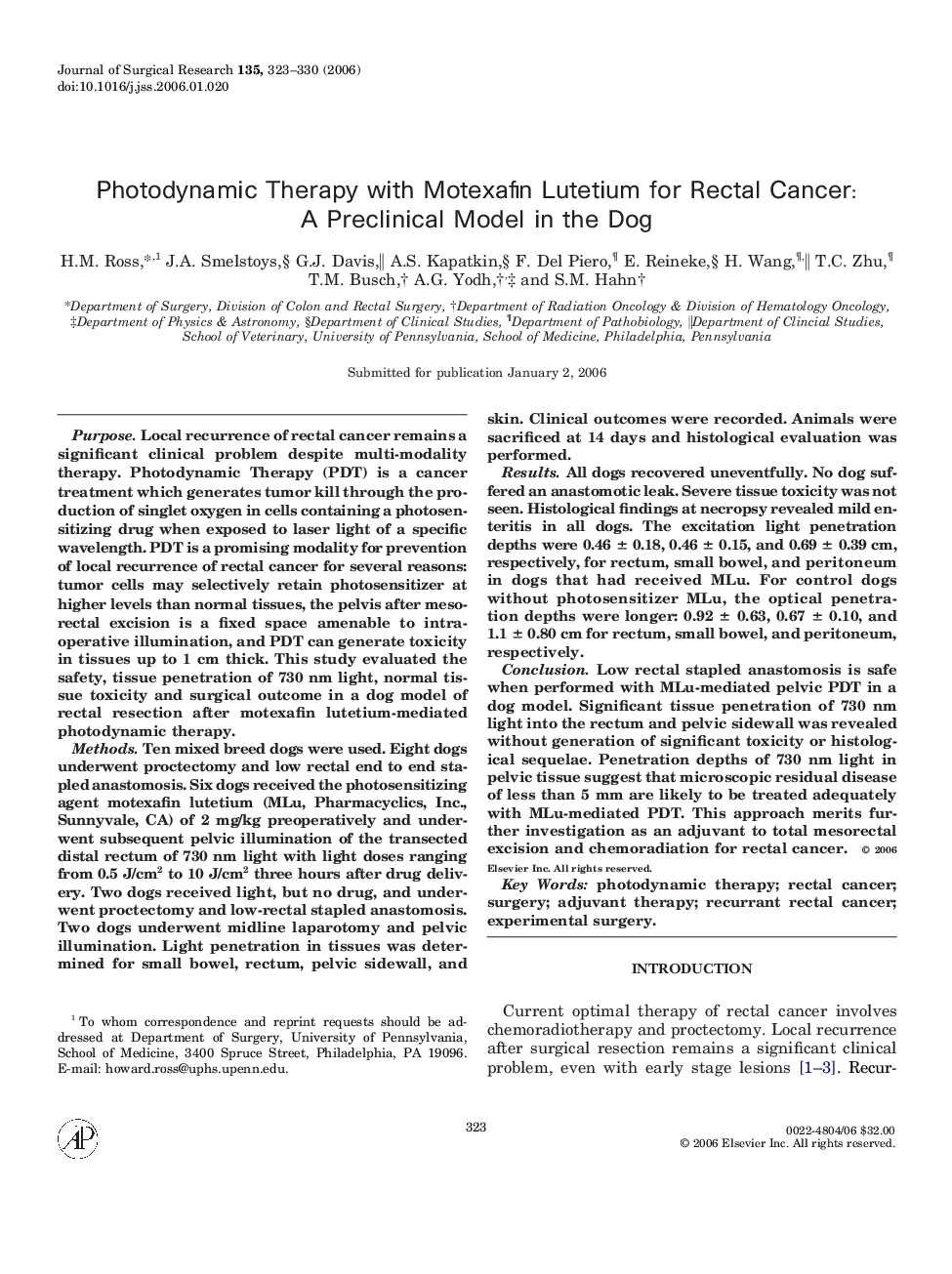| کد مقاله | کد نشریه | سال انتشار | مقاله انگلیسی | نسخه تمام متن |
|---|---|---|---|---|
| 4304900 | 1288518 | 2006 | 8 صفحه PDF | دانلود رایگان |

PurposeLocal recurrence of rectal cancer remains a significant clinical problem despite multi-modality therapy. Photodynamic Therapy (PDT) is a cancer treatment which generates tumor kill through the production of singlet oxygen in cells containing a photosensitizing drug when exposed to laser light of a specific wavelength. PDT is a promising modality for prevention of local recurrence of rectal cancer for several reasons: tumor cells may selectively retain photosensitizer at higher levels than normal tissues, the pelvis after mesorectal excision is a fixed space amenable to intra-operative illumination, and PDT can generate toxicity in tissues up to 1 cm thick. This study evaluated the safety, tissue penetration of 730 nm light, normal tissue toxicity and surgical outcome in a dog model of rectal resection after motexafin lutetium-mediated photodynamic therapy.MethodsTen mixed breed dogs were used. Eight dogs underwent proctectomy and low rectal end to end stapled anastomosis. Six dogs received the photosensitizing agent motexafin lutetium (MLu, Pharmacyclics, Inc., Sunnyvale, CA) of 2 mg/kg preoperatively and underwent subsequent pelvic illumination of the transected distal rectum of 730 nm light with light doses ranging from 0.5 J/cm2 to 10 J/cm2 three hours after drug delivery. Two dogs received light, but no drug, and underwent proctectomy and low-rectal stapled anastomosis. Two dogs underwent midline laparotomy and pelvic illumination. Light penetration in tissues was determined for small bowel, rectum, pelvic sidewall, and skin. Clinical outcomes were recorded. Animals were sacrificed at 14 days and histological evaluation was performed.ResultsAll dogs recovered uneventfully. No dog suffered an anastomotic leak. Severe tissue toxicity was not seen. Histological findings at necropsy revealed mild enteritis in all dogs. The excitation light penetration depths were 0.46 ± 0.18, 0.46 ± 0.15, and 0.69 ± 0.39 cm, respectively, for rectum, small bowel, and peritoneum in dogs that had received MLu. For control dogs without photosensitizer MLu, the optical penetration depths were longer: 0.92 ± 0.63, 0.67 ± 0.10, and 1.1 ± 0.80 cm for rectum, small bowel, and peritoneum, respectively.ConclusionLow rectal stapled anastomosis is safe when performed with MLu-mediated pelvic PDT in a dog model. Significant tissue penetration of 730 nm light into the rectum and pelvic sidewall was revealed without generation of significant toxicity or histological sequelae. Penetration depths of 730 nm light in pelvic tissue suggest that microscopic residual disease of less than 5 mm are likely to be treated adequately with MLu-mediated PDT. This approach merits further investigation as an adjuvant to total mesorectal excision and chemoradiation for rectal cancer.
Journal: Journal of Surgical Research - Volume 135, Issue 2, October 2006, Pages 323–330